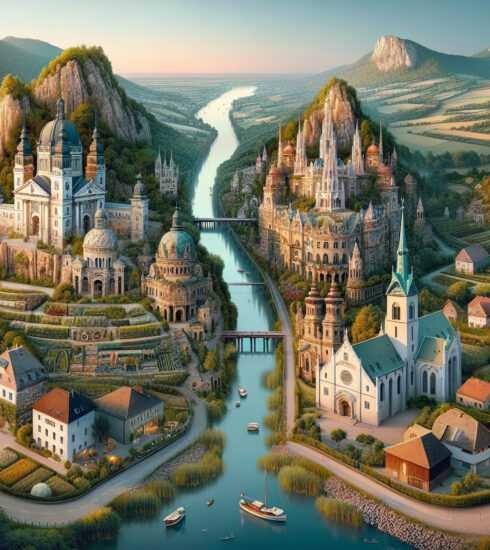Unveiling Hungarys Parliament: Discover the Architectural Marvels of Hungarys Parliament Building
Introduction
The Hungarian Parliament Building, also known as the Hungarian Parliament or the Parliament of Budapest, is a magnificent architectural marvel located in Budapest, Hungary. It is one of the most renowned landmarks in the country and an iconic symbol of Hungarian history and culture. The building serves as the seat of the National Assembly of Hungary, the legislative branch of the Hungarian government. With its awe-inspiring beauty, rich history, and cultural significance, the Hungarian Parliament Building attracts millions of visitors from around the world each year. In this article, we will explore the fascinating architectural features of this grand structure and delve into the historical context that surrounds it.
The History of the Hungarian Parliament Building
The construction of the Hungarian Parliament Building began in 1885 and was completed in 1904. The original design of the building was conceived by Hungarian architect Imre Steindl. Steindl won the architectural competition for the project with his neo-Gothic design, which was inspired by the Palace of Westminster in London. The construction process took nearly two decades due to various setbacks, including financial difficulties and the outbreak of World War I.
During the construction period, Hungary was part of the Austro-Hungarian Empire, and the decision to build a grand parliamentary structure was seen as a reflection of the country’s growing national identity and aspirations for independence. The Hungarian Parliament Building was intended to showcase Hungary’s commitment to democracy and the rule of law.
The Architectural Style of the Hungarian Parliament Building
The Hungarian Parliament Building is a masterpiece of neo-Gothic architecture. The style was chosen to reflect the historical and cultural influence of the Gothic period in Hungary. The building features intricate details, soaring spires, and an overall grandeur that is reminiscent of the great Gothic cathedrals of Europe. However, Steindl’s design also incorporates elements of Renaissance and Baroque architecture, resulting in a unique blend of styles that evokes both the past and the present.

The exterior of the Hungarian Parliament Building is adorned with elaborate ornamentation, including statues, reliefs, and decorative motifs. The facades are adorned with statues of Hungarian rulers, military heroes, and famous statesmen. Among the most prominent statues are those of King Stephen I, the first Christian king of Hungary, and Lajos Kossuth, a key figure in the Hungarian Revolution of 1848.
The central dome of the Hungarian Parliament Building is one of its most striking features, reaching a height of 96 meters. The dome is topped with a golden crown, which is a replica of the Holy Crown of Hungary, a symbol of the country’s independence and sovereignty.
The Interior of the Hungarian Parliament Building
The interior of the Hungarian Parliament Building is equally breathtaking. The main entrance opens into the grand central hall, which is adorned with marble columns, stained glass windows, and ornate chandeliers. The hall leads to the main staircase, which is a work of art in itself, featuring a stunning stone balustrade and a ceiling adorned with frescoes depicting scenes from Hungarian history.
The assembly hall, where the National Assembly meets, is located on the first floor. This magnificent chamber is decorated with richly carved wooden panels, frescoes, and stained glass windows. The hall can accommodate up to 386 members of parliament and is known for its acoustics, which allow speakers to be heard clearly even without amplification.
In addition to the assembly hall, the Hungarian Parliament Building houses numerous other rooms and halls, each with its own unique architectural features and historical significance. These include the Crown Room, where the Holy Crown of Hungary is displayed, the Senate Chamber, and the central library, which houses a vast collection of books and documents.
Interesting Facts About the Hungarian Parliament Building
– The Hungarian Parliament Building is the third-largest parliamentary building in the world, after the Palace of Parliament in Bucharest, Romania, and the Palace of Westminster in London.
– The construction of the building required the work of over 1,000 workers and more than 40 million bricks.
– The Hungarian Parliament Building is home to the largest parliamentary library in Europe, with a collection of over 500,000 books and documents.
– The building is also home to the Hungarian Crown Jewels, including the Holy Crown of Hungary, which is considered one of the most important historical artifacts in the country.
– The Hungarian Parliament Building has been featured in numerous films and television shows, including “The Grand Budapest Hotel” and “Mission: Impossible – Ghost Protocol.”
– The building is open to the public, and guided tours are available for visitors who wish to explore its magnificent interior.
Conclusion
The Hungarian Parliament Building stands as a testament to Hungary’s rich history, architectural prowess, and commitment to democracy. Its grand neo-Gothic design, intricate ornamentation, and historical significance make it one of the most iconic landmarks in Hungary. Whether you are a history buff, an architecture enthusiast, or simply someone who appreciates beauty, a visit to the Hungarian Parliament Building is a must. It is a place where the past and the present converge, showcasing the splendor of Hungarian culture and the enduring spirit of the Hungarian people.
For more information on the Hungarian Parliament Building, visit Wikipedia.





